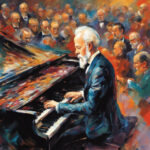Johann Sebastian Bach’s St John Passion stands as a testament to the power of music to convey profound emotion and drama. Written in the early 18th century, this sacred oratorio continues to captivate audiences with its rich harmonies, intricate melodies, and poignant text. In exploring why this masterpiece remains deeply moving, we uncover Bach’s genius in capturing the essence of the dramatic narrative through music.
At the heart of the St John Passion lies the retelling of the crucifixion of Jesus Christ, as depicted in the Gospel of John. Bach masterfully weaves together scripture passages, poetry, and chorales to create a compelling musical narrative that transports listeners to the heart of the Passion story. Through his intricate composition, Bach captures the range of emotions experienced by the characters, from the anguish of Jesus in the Garden of Gethsemane to the despair of Peter after his denial.
One of the most striking aspects of Bach’s St John Passion is its ability to evoke a visceral response from listeners. The music is imbued with a sense of urgency and intensity, mirroring the emotional turmoil of the events unfolding. In the opening chorus, “Herr, unser Herrscher” (Lord, our Ruler), the dissonant harmonies and driving rhythms set the stage for the impending drama, drawing listeners into the story from the outset.
Throughout the oratorio, Bach employs a variety of musical techniques to underscore the emotional depth of the text. The use of chromaticism, sudden dynamic shifts, and dramatic pauses all serve to heighten the tension and convey the sense of conflict inherent in the Passion narrative. In the aria “Es ist vollbracht” (It is accomplished), for example, the hauntingly beautiful melody and sparse accompaniment convey both the solemnity of Jesus’ sacrifice and the profound sense of fulfillment.
One of the most moving moments in the St John Passion is the chorale “Ruht wohl, ihr heiligen Gebeine” (Rest well, you holy limbs), which concludes the work. As the choir sings this tender farewell to Jesus, Bach’s music offers a sense of solace and consolation, providing a glimmer of hope amidst the darkness of the crucifixion. It is a moment of profound beauty and reflection, inviting listeners to contemplate the deeper meaning of Christ’s sacrifice.
While listening to a recording of Bach’s St John Passion can be a transformative experience in itself, there is truly nothing quite like witnessing a live performance. The immediacy of the music, combined with the energy and emotion of the performers, creates an immersive experience that is unmatched by any recording. In a live performance, the audience becomes an integral part of the drama, swept up in the ebb and flow of the music as it unfolds before them.
Moreover, attending a live performance of the St John Passion allows listeners to connect with a centuries-old tradition of sacred music. Bach’s oratorio has been performed countless times since its composition, yet each performance offers a fresh interpretation, breathing new life into the timeless story it tells. Whether performed in a grand concert hall or a humble church setting, the St John Passion continues to resonate with audiences of all backgrounds and beliefs, transcending the boundaries of time and culture.
Bach’s St John Passion remains a masterpiece of sacred music, moving listeners with its profound emotional depth and dramatic intensity. Through his inspired composition, Bach captures the essence of the Passion narrative, inviting audiences to experience the timeless drama of Christ’s sacrifice in a profoundly personal way. To witness a live performance of the St John Passion is to embark on a journey of musical and spiritual discovery, one that promises to leave a lasting impression on the heart and soul.










